Dollar Academy
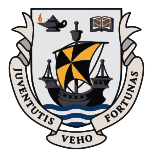 | |
| Motto |
Juventutis Veho Fortunas (Latin: "I carry the fortunes of youth") |
|---|---|
| Established | 1818 |
| Type | Independent Day and Boarding School |
| Rector | David Knappman |
| Chairman of Governors | John Cameron of Balbuthie CBE |
| Founder | Captain John McNabb |
| Location |
Academy Place Dollar Clackmannanshire FK14 7DU Scotland |
| Students | c. 1250 |
| Gender | Coeducational |
| Ages | 5–18 |
| Houses |
Atholl
Marr
Stewart
Argyll |
| Colours | Navy Blue & White |
| Publication | Fortunas (biannual publication) |
| School newspaper | The Galley Student Newspaper |
| Former pupils | Old Academicals |
| Website |
www |
Dollar Academy, founded in 1818 by benefaction of trader John McNabb, is a co-educational day and boarding school in Scotland. The open campus occupies a 70-acre (280,000 m2) site in the centre of the town of Dollar in Central Scotland. The school is located at the foot of the Ochil Hills and surrounded by Clackmannanshire countryside.
Overview
There are over 1250 pupils at Dollar Academy, making it the fourth largest independent school in Scotland. On a single campus, it is divided into three separate schools: the Prep School (Preps I to V for ages 5–10), the Junior School (Juniors I and II for ages 10–12) and the Senior School (Forms I to VI for ages 12 going on 18).
Around 100 of the pupils are boarders; the rest are day pupils, either from the village of Dollar itself or from the surrounding counties of Clackmannanshire, Stirlingshire, Perth and Kinross and Fife. Just 20% of the boarding pupils are from overseas, representing less than 4% of the total school roll. Foreign pupils come from a range of countries, including France, Spain, Germany, Russia, Ukraine, Romania, Bulgaria, Croatia, Moldova, as well as the United States and China. The remaining 80% of boarding students are British nationals.
Dollar Academy has over 70 sports and recreational activities on offer to pupils after the school day and over the weekend. Dollar Academy has produced international competitors across many disciplines, most notably in rugby and shooting.
Academic
Dollar Academy follows the Scottish education system, with pupils sitting a mixture of Intermediate 2 and National 5 examinations at the end of Form IV and Highers at the end of Form V/VI. Most courses in Form VI are at Advanced Higher level and a number of pupils study the Scottish Baccalaureate. All standard subjects are on offer at Dollar Academy. The school also teaches Classical Studies, Latin, Greek and Mandarin. IT training is provided to all, and music, art and drama are compulsory for Forms 1 and 2.
Combined Cadet Force
Dollar Academy's CCf (Combined Cadet Force) have won the Scottish Schools' CCF skills competition (formerly the Highland CCF Tactical Competition) several times and most recently in 2014 and 2016. Dollar Academy's CCF was also the first Scottish CCF to win the Welbeck DSFC Cadet Leadership Challenge in 2013 and repeated this in 2014 and 2016. The CCF First Aid team is also extremely successful winning the Scottish National every year since 2003 and winning the CCF UK Nationals seven times in nine times in the last eleven years. The school is also the only Scottish school in the last fifty years to win the Ashburton Shield at Bisley, winning in 2005 and 2013.
The school has two main pipe bands, both of which have been very successful in competition. The "A" band won the Scottish Schools CCF Pipes and Drums competition every year from 2000 to 2012 and 2014 and 2015,[1][2] as well as winning the RSPBA World Pipe Band Championships in 2010, 2014 and 2015. In 2013, the band was placed first at the last "Major of the season, the prestigious Cowal Gathering. The band continues to achieve an extraordinary catalogue of successes and had a particularly successful year in 2015, winning the Scottish, British, United Kingdom, European and World Championships,[3] leading to them being awarded the title "Champion of Champions". Additionally, the Novice, or "B" band continues to achieve success, winning the British, Scottish and European Championships in 2015,[4] and being crowned "Champion of "Champions"[5] as a result of their success throughout the season.
The school day
The school day begins at 8:45 am, when pupils must be in Registration in their Form Tutor Groups to be registered at the beginning of each day. In each year there are around 7 or 8 such classes, each of about 17–25 pupils. On Mondays, Wednesdays and Fridays pupils attend Morning Assembly from 9:00 am to 9:15 am. This consists of an academic parade, a hymn, a bible reading and a prayer, followed by announcements about the forthcoming days. On Tuesdays and Thursdays there is an extended registration and lessons begin at 9:05 am, with classes starting ten minutes earlier than usual.
There are five periods in the day, each lasting one hour. First period begins at 9:15 am and finishes and 10:15 am, and is followed by second period which ends at 11:15 am. Between 11:15 am and 11:30 am is morning break (there is extended break on a Friday lasting an extra five minutes as staff have a meeting in the library). Third period is from 11:30 am to 12:30 am, and is followed by lunch, which finishes at 1:25 pm. Fourth and fifth period follow, ending at 3:25 pm. Buses leave Dollar from 3:35 to 3:55pm. After-school activities usually take place between 3:30 pm and 5:00pm. 'Late buses' leave Dollar at 5:00–5:30pm.
History
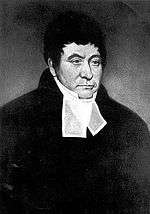
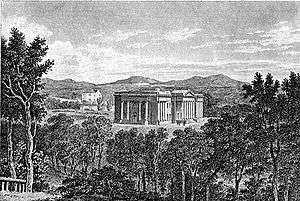
Dollar was founded in 1818 after John McNab or McNabb, a merchant, bequeathed part of his fortune – £65,000 – to provide "a charity or school for the poor of the parish of Dollar where I was born".[6] McNabb died in 1802 but it took another sixteen years before the school opened it doors after much debate about how to use the bequest. It was in 1815 that the Rev. Andrew Mylne, Minister of Dollar, along with fellow Trustees conceived of a great academy to educate the boys and girls of the parish, and also pupils from outside Dollar, who would board with teachers. Full fees would be charged to ‘non-residenters’, while parish pupils would pay fees on a sliding scale, with some receiving free education. To attract pupils from outside the parish, excellent teachers would be appointed.
Mylne engaged the eminent architect, William Henry Playfair, who designed a fitting structure with a splendid Doric façade. John McNabb’s School or Dollar Institution (later Dollar Academy) was finally completed in 1821. In 1818, teaching started, with Rev Andrew Mylne as the first school Rector.
The original campus was landscaped into several gardens including two ponds. In the 19th century the school had a strong emphasis on horticulture, and all pupils were allocated plots in the extensive school grounds. Several curious rarities exist in the school grounds in arboricultural terms, including several sequoias. In the 19th century, Dollar pupils sat the Cambridge Examinations or the Indian Civil Service Examinations. It was pioneering in its teaching of science at a time when most private schools followed an exclusively classical education.
John McNabb’s coffin was discovered in the early 1930s in the crypt under Old Gravel Lane Meeting House in London. Former pupils had his remains cremated, and the ashes of Captain John McNabb now rest above the Bronze Doors of the school founded in his name.
Architecture
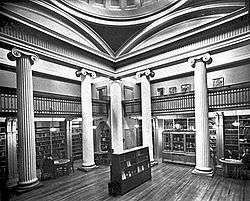
The principal school building was designed by Scottish architect William Henry Playfair. The interior of the Playfair building was gutted by a fire in 1961, but Playfair's Greek-style facade remained intact and the school was re-opened in 1966 by former pupil Lord Heyworth, having been visited by The Queen and Prince Philip in 1963. The assembly hall was rebuilt after the fire. The school library is a "whispering gallery" because of its domed ceiling.
There are numerous other buildings on the campus, including the Dewar Building for science, the Younger Building for mathematics and business studies, the Gibson Building for music, the Iona Building for home economics, the Maguire Building for sport, art and drama and the most recent building the west water building . There are also several rugby, cricket and football pitches, and new all-weather surface for hockey and tennis. Sport is supported by the Boys' and Girls' pavilions, the Games Hall and the swimming pool. In 2005, the new Maguire Building was opened with facilities for Art, PE and Drama and with the circular Captain’s Room for conferences and meetings.
Recently a new building has been built the west water building in 2016
Boarding houses
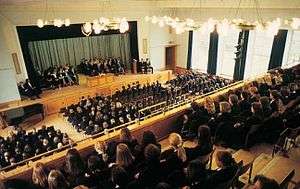
The original boarding accommodation was built at the same time as the original Playfair Building. These houses were situated in Academy Place to accommodate teachers and boarders. Over the years these buildings have been modernised and study bedrooms introduced. The existing boarding houses are all refurbished period buildings.
There are spaces for 99 boarders in the Academy's three boarding houses. Both weekly boarders (Monday – Friday) and full boarders are accepted.
- Argyll House – girls aged 10–18
- Heyworth House – girls aged 10–18
- McNabb–Tait House – boys aged 10–18
Though the majority of pupils do not board, every pupil belongs to a House. Originally there were five boys' houses, instituted in 1911, hence the term quint. The Quint Cup and House Cup are awarded annually at Prize-Giving. Today there are four quints:
Female houses and male quints
Former pupils' children are traditionally put into the same house as their father, mother, brother, or sister. The names of quints and houses were merged in 2009; previously, male quints followed the names: Castle (Atholl), Devon (Mar), Glen (Stewart), and Hill (Argyll). The fifth male quint was McNabb (purple) but this was dropped in 1937.
Traditions
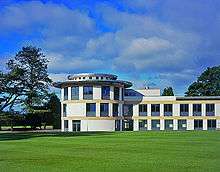
Each year full colours and half colours are awarded to senior pupils for achievement in sporting or cultural pursuits. These awards merit piping on the school blazer (blue for cultural, white for sporting) and/or a distinctive blazer badge. Internationalists' Award ties are presented to pupils, prep, junior and senior, who has represented their country in sporting or cultural activities.[7] Sixth Form pupils are also given a distinctive silver tie, and prefects wear white and blue bands round the blazer sleeves.
The senior six (or top six) are the most senior prefects in the school, elected by a ballot of Forms IV, V and VI. Those with the highest numbers of votes are selected for the "College of Cardinals", who vote among themselves to elect a Head Boy, Head Girl and two deputies for each.
Two school songs were composed in 1912, but neither was officially adopted. "Here in a Fair Green Valley…" by the poet W. K. Holmes and music by Marc Anthony became the official school song sung at prize-giving each year between 1929–1993. This was then replaced by the Academy Hymn, "O God of Bethel!" until 2007, when the popularity and metaphorical significance of "Will Your Anchor Hold?" (Hymn 412) caused it to be adopted for this purpose.
The Commemoration of the Founder is said by the Head Boy and Head Girl at prize-giving:
"Let us now, in pious duty, remember thankfully all those who by their noble generosity have founded this school, and bestowed upon it great and notable benefactions...
Let us now remember all these benefactors in simple gratitude. We enjoy a great heritage. But privilege carries with it a call to responsibility. What was nobly begun must be nobly continued, in the spirit of the Elizabethan mariners who prayed in the words of Sir Francis Drake:
O Lord, When thou givest to thy servants to endeavour any great matter, grant us also to know that it is not the beginning, but the continuing of the same until it be thoroughly finished, which yieldeth the true glory.
Amen."
There are many traditional events in the school calendar including: annual Christmas Dances, Boarders' Ceilidh, Sixth Form Dinner, Burns' Supper (Form VI), the Summer Ball (Form VI), the Junior Musical, the Senior Musical, the Sixth Form Play, the Christmas Carol Concert, the Teddy Bears' Picnic (Prep School), Prep School Sports Day, Sports Weekend and the biennial Sponsored Walk.
Rectors
- The Rev. Dr Andrew Mylne (1818–1850)
- The Rev. Dr Thomas Burbidge (1850–1851)
- The Rev. John Milne (1851–1868)
- The Rev. Dr William Barrack (1868–1878)
- George Thom (1878–1902)
- Charles Dougall (1902–1923)
- Hugh Martin (1923–1936)
- Harry Bell (1936–1960)
- James Millar (1960–1962) – Acting Rector
- Graham Richardson (1962–1975)
- Ian Hendry (1975–1984)
- Lloyd Harrison (1984–1994)
- John Robertson (1994–2010)
- David Knapman (2010 onwards)
Prize day speakers
This list is incomplete, and lists speakers from 1937 to the present. The suffix FP denotes a former pupil of the Academy.
- 1937 Rev George Blair
- 1938 Sir William Robieson, Governor
- 1939 Sir John Forbes Watson
- 1940 Rev W S Wilson, Governor
- 1941 Col Sir Alexander Russell, FP
- 1942 Very Rev Principal G S Duncan, Governor
- 1943 Rev W D O Rose MA, Governor
- 1944 Professor James M Mackintosh, Governor
- 1945 Sir W McNair Snadden, FP
- 1946 Col E C Cross, FP
- 1947 Sir Laurence Heyworth, FP
- 1948 John D Westwood, FP
- 1949 Rev Canon G. K. Sturrock Clarke, Governor
- 1950 Rev Dr J. Lynn, Governor
- 1951 Peter Norwell, FP & Governor
- 1952 Dr P. P. Brodie, Governor
- 1953 James A. Williamson, FP
- 1954 Alan C. Mackay, FP
- 1955 Prof. T. Erskine Wright, Governor
- 1956 Air Vice Marshal Ronald Graham
- 1957 The Earl of Mar and Kellie, Governor
- 1958 Captain J. P. Younger, CBE
- 1959 Dr T. Crouther Gordon, Governor
- 1960 Douglas Cruickshank, FP
- 1961 Dr William Parker, FP
- 1962 David Walker, Governor
- 1963 W. Kersley Holmes, FP
- 1964 Col. S. J. L. Hardie
- 1965 W. McFarlane Gray
- 1966 Dr T. L. Cottrell
- 1967 Prof. J. Bennett Millar, Governor
- 1968 George Sweet, FP
- 1969 Frank Clark, FP
- 1970 Lt Gen. Sir Derek Lang; Commander-in-Chief of the Army in Scotland
- 1971 Sheriff J. Irvine Smith
- 1972 Dr Colin Miller
- 1973 Sir Charles Illingworth; surgeon
- 1974 John Webster, FP
- 1975 Prof Nisbet, FP
- 1976 Dr Crammond
- 1977 Prof. Donald MacKay, FP
- 1978 Dr Peter P. Brodie, Governor; Moderator of the General Assembly of the Church of Scotland in 1978
- 1979 Professor A. G. M. Campbell, FP
- 1980 Hector Munro, CBE
- 1981 John Cameron of Balbuthie, CBE, FP
- 1982 R. deC Chapman, FP
- 1983 Prof. Christopher Blake, FP
- 1984 Sir Ian Morrow, FP
- 1985 James Miller, FP
- 1986 Dennison Berwick; travel writer
- 1987 Group Captain Eric King, FP
- 1988 Prof. Struther Arnott
- 1989 Chief Constable Ian Oliver
- 1990 Janet Caird, FP
- 1991 Prof. Lalage Brown
- 1992 R. Macleod, FP
- 1993 C. Peter Kimber
- 1994 Klaus-Jurgen Moll
- 1995 R. deC Chapman, FP
- 1996 Norman Shanks
- 1997 Jacqueline Smith, FP
- 1998 Lt Col. Derek Napier, FP
- 1999 Joanna Trollope, OBE; novelist
- 2000 Dr Andrew Cubie, FP;
- 2001 Andrew Neil; editor, The Sunday Times; chairman, Sky TV; owner, The Business, The Spectator
- 2002 Eileen Kamm
- 2003 George Reid, MSP, FP; Presiding Officer of the Scottish Parliament
- 2004 Gerald Malone, MP; former Conservative Minister for Health
- 2005 Alex Salmond, MP, MSP
- 2006 Caroline Flanagan; President, Law Society of Scotland
- 2007 Professor C. Duncan Rice, Principal of the University of Aberdeen
- 2008 Fraser Nelson, FP; editor, The Spectator
- 2009 Johanna Boyd, FP
- 2010 Keith M Brown, FP
- 2011 Abeer Macintyre
- 2012 Sir Brian Souter
- 2013 Professor Christopher Riley
- 2014 Mr Kenneth MacDonald
- 2015
- 2016 Mr Mark Beaumont
Former Pupils
Politics
- Herbert Beresford, Canadian politician
- Sir George Christopher Molesworth Birdwood, colonial administrator in India
- Lord Constable CBE, KC, Conservative politician and judge
- William Scott Fell, Australian Liberal politician and businessman
- Sir John Dunlop Imrie FRSE CBE, City Chamberlain of Edinburgh 1926–1951, First Government Commissioner of Trinidad and Tobago 1951–53[8]
- Sir George Reid, Lord Lieutenant for Clackmannanshire and former Presiding Officer of the Scottish Parliament
- Sir William Snadden Bt, Conservative politician
- Sir Frank Swettenham, first Resident-General of the Federated Malay States
- Mandy Telford, former President of the National Union of Students
- James Galloway Weir, Liberal MP and sewing machine entrepreneur
- Sir Frank Swettenham British colonial official
Sport
- Jim Thompson, Scottish 7s rugby player
- John Barclay, Scottish rugby player
- Hamish Brown MBE mountaineer and writer
- Dr Adam Kelso Fulton, Scottish rugby player
- Cameron Glasgow, Scottish rugby player
- Susan Jackson, Rifle shooter, three times Commonwealth Games Medallist
- Rory Lawson, Scottish rugby player
- Graeme Morrison, Scottish rugby player
- Jennifer McIntosh, Rifle shooter, five times Commonwealth Games Medallist and Olympian
- Shirley McIntosh, Rifle shooter, four times Commonwealth Games Medallist
Royal or noble
- The Master of Bruce (future 13th Earl of Elgin)
- Various members of the Ethiopian Imperial Family including the nephews of Haile Selassie
- James MacArthur of Milton, Chief of Clan Arthur
- The Master of Moncreiff (future 7th Baron Moncreiff)
- Sir Arthur Bolt Nicolson, 9th Bt
Literary
- Henry Clark Barlow, literary scholar
- Ian Hamilton Finlay, poet, playwright, artist and experimental garden designer
- Alan Johnston, BBC Gaza correspondent taken hostage in 2007
- Malcolm Lyon, author
- Jo L. Walton, poet
Business
- David Greig, landowner
- Charles William Maxwell Heddle, businessman
- Lord Heyworth of Oxton, Chairman of Unilever and ICI
- Sir Ian Morrow, businessman
- Gregor Lawson, co-founder of morphsuits
- Sir Wei Yuk – nineteenth-century Hong Kong businessman and legislator
- Skye Scott – Director SLSV Limited
Law
- Lord Brodie, judge
- Andrew Constable, Lord Constable
- Caroline Flanagan, President of the Law Society of Scotland 2005
- Richard Keen, Scottish lawyer and Dean of the Faculty of Advocates
Science
- Sir James Dewar, inventor of the Vacuum flask
- John Archibald Watt Dollar, veterinary to four monarchs
- George Alexander Gibson, physician and geologist
- Sir David Gill, astronomer
- Matthew Hay, physician and forensic expert
- John Robertson Henderson FRSE zoologist and antiquary
Miscellaneous
- John Macmillan Brown, university professor and administrator
- Sara Mendes da Costa, voice of the speaking clock
- Sir Charles Morton Forbes, naval officer
- William Frederick Harvey FRSE CIE public health expert, Director of the Central Research Institute in India, Vice President of the Royal Society of Edinburgh
- Sir Hector Hetherington, social philosopher
- Tom Kitchin, Michelin starred Chef
- Colin Mackenzie, army and political officer in India
- George Henry Paulin, sculptor
Notable former teachers
- Andrew Bell (1753–1832), educationalist and divine (Mathematics Master)
- Patrick Gibson (1782–1829), landscape painter (Professor of Painting)
- William Tennant (1784–1848), linguist and poet (Master of Classical and Oriental Languages)
- Prof David Laird Adams (1837–1892) (Classical and Oriental languages)[9]
References
- ↑ Marjoribanks, Kaiya (2 July 2008). "Dollar Keep Tight Grip on Trophy". Stirling Observer. Retrieved 19 October 2008.
- ↑ http://www.rspba.org/results/displaybanddetail.php?Year=2015&Band=Dollar%20Academy. Missing or empty
|title=(help) - ↑ "RSPBA 2015 Results".
- ↑ "RSPBA 2014 Dollar Academy Results".
- ↑ "Dollar Academy News Article – World Pipe Band Championships".
- ↑ "History of Dollar Academy". Archived from the original on 7 January 2007. Retrieved 3 August 2006.
- ↑ "Dollar Academy Information for Pupils Booklet 2014–2015" (PDF).
- ↑ BIOGRAPHICAL INDEX OF FORMER FELLOWS OF THE ROYAL SOCIETY OF EDINBURGH 1783 – 2002 (PDF). The Royal Society of Edinburgh. July 2006. ISBN 0 902 198 84 X.
- ↑ https://www.flickr.com/photos/110960089@N08/11276544563